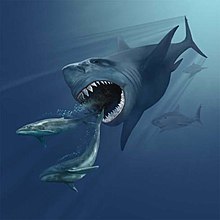When it comes to sharks, they are known as the terror of the sea, but among them, the most gigantic and powerful was the “Megalodon”. Megalodon was a shark that lived in the sea from about 23 million years ago to about 1.5 million years ago, and its length was over 15 meters. The largest shark known today is the great white shark, which is about 6 meters long, so the difference is obvious.
But did Megalodon really go extinct? There are various claims and evidence for its existence. In this article, we will introduce the possibility of Megalodon being alive today, with urban legends and trivia. Whether you believe it or not is up to you, but please read on.
Characteristics and ecology of Megalodon
First, let’s briefly explain the characteristics and ecology of Megalodon. Megalodon belongs to the order Lamniformes of sharks, and there are various opinions on its classification, but it is generally classified into the genus Otodus or Carcharocles. The scientific name is Otodus megalodon or Carcharocles megalodon. In Japanese, it is called Mukashioohohojirozame.
The biggest feature of Megalodon is its size. Its length is estimated to be over 15 meters, and the largest individual may have exceeded 20 meters. Its weight is also about 50 tons. This is larger and heavier than the largest fish today, such as whale sharks and basking sharks.
In addition, its biting force was also tremendous, estimated to exert about 180,000 newtons (about 18 tons) of force. This is about three times that of the current great white shark. Its teeth were thick and sturdy, made to grab and break bones of prey. The size of its teeth was about 10 to 15 centimeters on average, but the largest ones were over 18 centimeters.
Megalodon was distributed in all ocean regions, and lived in a wide range from warm coastal waters to deep sea. Its prey included small to medium-sized whales and seals as mammals, and sea turtles as reptiles. Juveniles ate fish and small whales.
Extinction theory and its basis
Megalodon is said to have gone extinct about 1.5 million years ago, but there are various theories as to why. The most plausible theory is that climate change caused changes in the marine environment that affected it. The ice age that began about 2.5 million years ago lowered the sea temperature and sea level. This reduced Megalodon’s habitat and food sources.
In particular, Megalodon’s main prey, baleen whales, moved to polar regions and increased their population. On the other hand, Megalodon was a shark that preferred warm waters and could not follow them to polar regions. Also, baleen whales became larger and could escape from Megalodon’s predation.
In addition, climate change may have increased other predators that competed with Megalodon. For example, small to medium-sized whales such as orcas and Livyatan could adapt to lower temperatures and expand their distribution to polar regions. These whales not only targeted the same prey as Megalodon, but also attacked Megalodon itself.
Furthermore, small sharks such as great white sharks may have competed with Megalodon. Great white sharks can swim fast and catch prey more efficiently than Megalodon. Also, great white sharks can operate in deep sea and take away Megalodon’s hiding places.
Survival theory and its basis
On the other hand, there is also a theory that Megalodon did not go extinct but is still alive today. The basis for this theory includes:
Recent sightings
Reports of giant sharks similar to Megalodon
The example of coelacanth
As for recent sightings, the most famous one is “Submarine”, a giant shark that was introduced in a program called “Shark Week” aired by Discovery Channel in 2013. This shark was allegedly spotted off South Africa and was estimated to be between 10 meters and 16 meters long. This size is impossible for any known shark today, so some people speculated that it might be a Megalodon.
Also, a giant shark carcass found in Indonesia in 2018 became a topic of conversation. This shark was about 9 meters long and had features similar to Megalodon. The shape and size of its teeth, the shape of its head, and so on matched Megalodon. However, this shark was also said to be a species of great white shark, and it could not be confirmed as Megalodon.
Furthermore, the example of coelacanth is also cited as a basis for the survival theory. Coelacanth is an ancient fish that has existed for about 400 million years and was thought to have gone extinct about 65 million years ago. However, in 1938, a living coelacanth was discovered off South Africa, and since then it has been sighted in the Indian Ocean and Pacific Ocean. This is an amazing example of a creature that was thought to be extinct but was actually alive.
As you can see, there are various claims and evidence for the possibility of Megalodon being alive today. However, none of these evidence are certain and there are many doubtful points. Also, if Megalodon is still alive, its habitat and population are unknown. It is also unclear how it adapts to the current marine environment and food chain.
Summary
Is the largest shark in history, “Megalodon”, still alive? There are both extinction and survival theories for this question. The extinction theory is that climate change and competition with other predators reduced its habitat and food sources. The survival theory is based on recent sightings, reports of giant sharks similar to Megalodon, and the example of coelacanth.
However, these theories are all hypotheses and there is no conclusive evidence. Whether Megalodon went extinct or not is still a mystery. If Megalodon is still alive, is it living quietly in the depths of the sea? Or will it someday come into human sight? The answer is known by the sea.




_returns_to_the_General_Dynamics_Electric_Boat_shipyard.jpg/450px-US_Navy_040730-N-1234E-002_PCU_Virginia_(SSN_774)_returns_to_the_General_Dynamics_Electric_Boat_shipyard.jpg)





